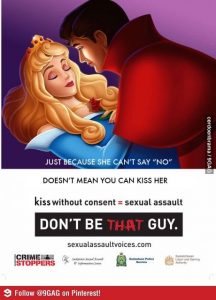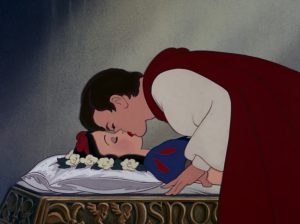
In this photo, an organization has used the iconic picture of Sleeping Beauty’s “True Love’s Kiss” to represent lack of consent. https://s-media-cache-ak0.pinimg.com/736x/38/20/2f/38202fe5e990eebc3c144e4469ac2fa7.jpg
Beyond the damaging portrayal of women as domesticated creatures and the exaggeration of their physical appearances, there are also indisputable references and allusions to rape and sexual assault in the Disney Princess franchise. The overall permeating storyline of the knight in shining armor that is the princess’ savior “denies women the agency” or any ability to make her own decisions (Weiss). This is exhibited in the way the men dominate the screen and the female characters, leading to issues of power, control and mastery that are rooted in rape culture. Taking away a woman’s authority and sense of self by allowing men to dominate them sexually and emotionally is extremely dangerous for young children to view and digest as a form of entertainment.

Snow White is kissed while unconscious by her Prince Charming. This represents male dominance and lack of consent. http://images2.fanpop.com/images/photos/8400000/Snow-White-and-her-Prince-The-Kiss-snow-white-and-the-seven-dwarfs-8463421-900-672.jpg

This displays the infamous kiss between Sleeping Beauty and her Prince, even though Princess Aurora is unconscious and is unable to give consent. http://vignette2.wikia.nocookie.net/powerlisting/images/6/61/Sleeping-beauty-kiss.jpg/revision/latest?cb=20140526074512
Further, there is a consistent storyline of lack of consent. In both Snow White and Sleeping Beauty, the princesses are unable to give consent due to their lack of consciousness as their princes kiss them in order to “save” them from their slumber (see images above). While many may find this a harmless part of the storylines or a heroic attempt to save the princesses from their possible deaths, it is extremely deleterious to display these interactions that lack blatant consent due to Aurora’s and Snow White’s inability to speak or disagree in any way. Specifically, Sleeping Beauty has a long history and even more current depiction of rape within the story. In the original Italian version of Sleeping Beauty, known as Sun, Moon, and Talia, Princess Aurora is awakened by repeated rape by the King and eventually gives birth to two children while unconscious. While both grotesque and unrealistic, this original storyline sets the precedent for the adaptations created in later decades. Only when the Grimm Brothers created an abridged, more “appropriate” version of the story was the true love’s kiss designed. This form of sexual action is not appropriate either due to its features of force and Aurora’s inability to protest. However, even after the release of Maleficent, Disney’s 2016 production of the back story of Sleeping Beauty, there were still concerns of allegories surrounding “metaphorical rape” (Doyle). Both in the scene concerning Maleficent being drugged and having her wings ripped off of her while unconscious, and the revenge that she attempts to take on Princess Aurora, rape is not as hidden or discreet as Disney may have intended. While Maleficent may not be aimed at the same audience as the original Disney movies, the projection of this inappropriate and offensive storyline should not be permitted.

Belle is attempting to get away from Gaston’s aggressive grip, something she clearly did not ask for. https://iwantedwings.files.wordpress.com/2016/07/beauty-and-the-beast-disneyscreencaps-com-8166-2.jpg?w=1200
Another example of rape culture is the theme of romantic kidnapping. In Beauty and the Beast, Belle is kidnapped by the Beast and held captive in his palace. Even when she attempts to run away and is bombarded by wolves in the wilderness, the Beast comes to save her — and yet imprisons her once more. However, this storyline of a happy ever after is flawed — Belle was originally attempting to escape the Beast, her captor, and yet he is rewarded for taking her hostage once more. For kids to believe that kidnapping is romantic in any form at such a young age is extremely harmful to how they will grow up and learn to develop healthy relationships. Allowing a child to watch men take away the vehicle of choice for a woman teaches them it is exceptional and even normal.
Finally, Ariel’s lack of agency throughout The Little Mermaid is unfathomable. Making Ariel voicelessness for the majority of the movie literally removes her ability to express opinion, discontent, and most importantly, consent. This leads the characters in the movie, especially the prince, to assume and create alternatives to what Ariel is thinking or attempting to express. Removing a woman’s ability to express beliefs and concerns is a core issue in our society that continues to perpetuate inequality between men and women and further allows for patriarchal dominance and control. Additionally, making assumptions of what a woman, or any person, may want in a relationship is extremely disturbing and could lead to many issues regarding authorization and agreement.
Emma Hatheway